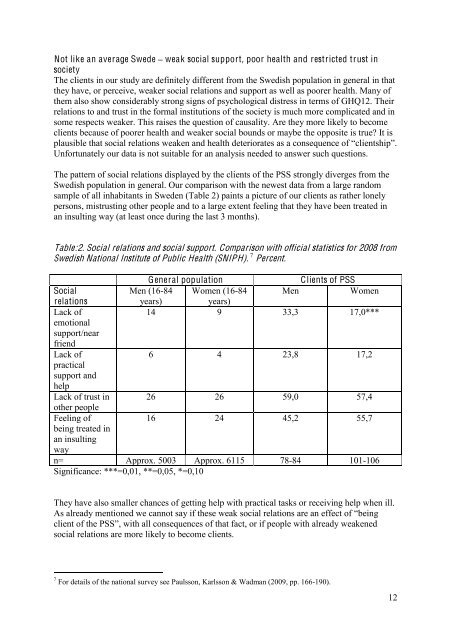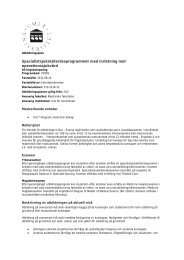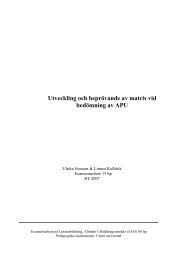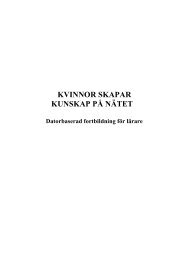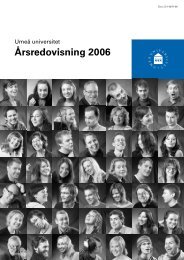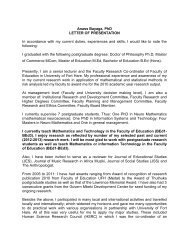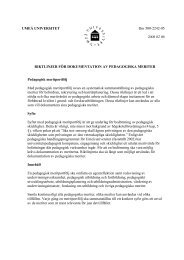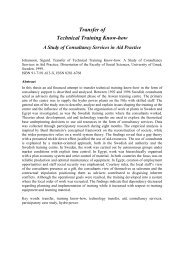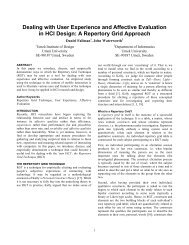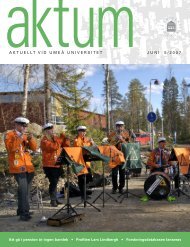Organisational Structure as Barrier or Support in the Personal Social ...
Organisational Structure as Barrier or Support in the Personal Social ...
Organisational Structure as Barrier or Support in the Personal Social ...
You also want an ePaper? Increase the reach of your titles
YUMPU automatically turns print PDFs into web optimized ePapers that Google loves.
Not like an average Swede – weak social supp<strong>or</strong>t, po<strong>or</strong> health and restricted trust <strong>in</strong>societyThe clients <strong>in</strong> our study are def<strong>in</strong>itely different from <strong>the</strong> Swedish population <strong>in</strong> general <strong>in</strong> that<strong>the</strong>y have, <strong>or</strong> perceive, weaker social relations and supp<strong>or</strong>t <strong>as</strong> well <strong>as</strong> po<strong>or</strong>er health. Many of<strong>the</strong>m also show considerably strong signs of psychological distress <strong>in</strong> terms of GHQ12. Theirrelations to and trust <strong>in</strong> <strong>the</strong> f<strong>or</strong>mal <strong>in</strong>stitutions of <strong>the</strong> society is much m<strong>or</strong>e complicated and <strong>in</strong>some respects weaker. This raises <strong>the</strong> question of causality. Are <strong>the</strong>y m<strong>or</strong>e likely to becomeclients because of po<strong>or</strong>er health and weaker social bounds <strong>or</strong> maybe <strong>the</strong> opposite is true? It isplausible that social relations weaken and health deteri<strong>or</strong>ates <strong>as</strong> a consequence of “clientship”.Unf<strong>or</strong>tunately our data is not suitable f<strong>or</strong> an analysis needed to answer such questions.The pattern of social relations displayed by <strong>the</strong> clients of <strong>the</strong> PSS strongly diverges from <strong>the</strong>Swedish population <strong>in</strong> general. Our comparison with <strong>the</strong> newest data from a large randomsample of all <strong>in</strong>habitants <strong>in</strong> Sweden (Table 2) pa<strong>in</strong>ts a picture of our clients <strong>as</strong> ra<strong>the</strong>r lonelypersons, mistrust<strong>in</strong>g o<strong>the</strong>r people and to a large extent feel<strong>in</strong>g that <strong>the</strong>y have been treated <strong>in</strong>an <strong>in</strong>sult<strong>in</strong>g way (at le<strong>as</strong>t once dur<strong>in</strong>g <strong>the</strong> l<strong>as</strong>t 3 months).Table:2. <strong>Social</strong> relations and social supp<strong>or</strong>t. Comparison with official statistics f<strong>or</strong> 2008 fromSwedish National Institute of Public Health (SNIPH). 7 Percent.General populationClients of PSS<strong>Social</strong>Men (16-84 Women (16-84 MenWomenrelationsyears)years)Lack of14 9 33,3 17,0***emotionalsupp<strong>or</strong>t/nearfriendLack of6 4 23,8 17,2practicalsupp<strong>or</strong>t andhelpLack of trust <strong>in</strong> 26 26 59,0 57,4o<strong>the</strong>r peopleFeel<strong>in</strong>g of16 24 45,2 55,7be<strong>in</strong>g treated <strong>in</strong>an <strong>in</strong>sult<strong>in</strong>gwayn= Approx. 5003 Approx. 6115 78-84 101-106Significance: ***=0,01, **=0,05, *=0,10They have also smaller chances of gett<strong>in</strong>g help with practical t<strong>as</strong>ks <strong>or</strong> receiv<strong>in</strong>g help when ill.As already mentioned we cannot say if <strong>the</strong>se weak social relations are an effect of “be<strong>in</strong>gclient of <strong>the</strong> PSS”, with all consequences of that fact, <strong>or</strong> if people with already weakenedsocial relations are m<strong>or</strong>e likely to become clients.7 F<strong>or</strong> details of <strong>the</strong> national survey see Paulsson, Karlsson & Wadman (2009, pp. 166-190).12


